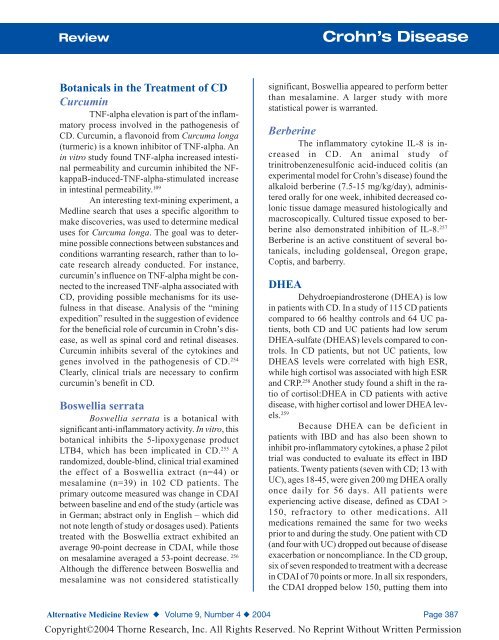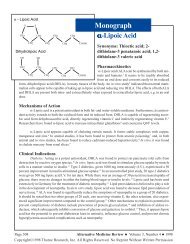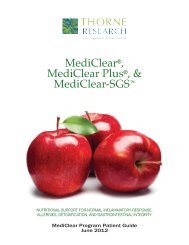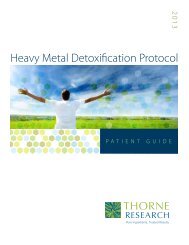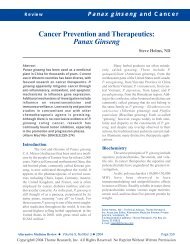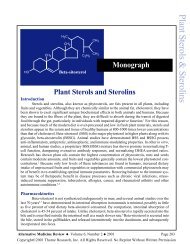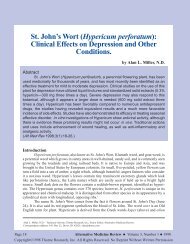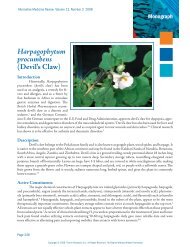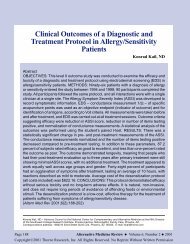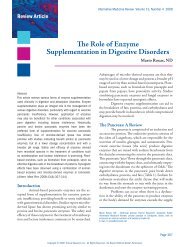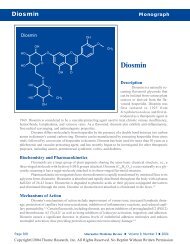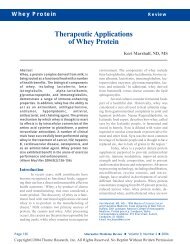Crohn's Disease - Thorne Research
Crohn's Disease - Thorne Research
Crohn's Disease - Thorne Research
Create successful ePaper yourself
Turn your PDF publications into a flip-book with our unique Google optimized e-Paper software.
ReviewCrohn’s <strong>Disease</strong>Botanicals in the Treatment of CDCurcuminTNF-alpha elevation is part of the inflammatoryprocess involved in the pathogenesis ofCD. Curcumin, a flavonoid from Curcuma longa(turmeric) is a known inhibitor of TNF-alpha. Anin vitro study found TNF-alpha increased intestinalpermeability and curcumin inhibited the NFkappaB-induced-TNF-alpha-stimulatedincreasein intestinal permeability. 109An interesting text-mining experiment, aMedline search that uses a specific algorithm tomake discoveries, was used to determine medicaluses for Curcuma longa. The goal was to determinepossible connections between substances andconditions warranting research, rather than to locateresearch already conducted. For instance,curcumin’s influence on TNF-alpha might be connectedto the increased TNF-alpha associated withCD, providing possible mechanisms for its usefulnessin that disease. Analysis of the “miningexpedition” resulted in the suggestion of evidencefor the beneficial role of curcumin in Crohn’s disease,as well as spinal cord and retinal diseases.Curcumin inhibits several of the cytokines andgenes involved in the pathogenesis of CD. 254Clearly, clinical trials are necessary to confirmcurcumin’s benefit in CD.Boswellia serrataBoswellia serrata is a botanical withsignificant anti-inflammatory activity. In vitro, thisbotanical inhibits the 5-lipoxygenase productLTB4, which has been implicated in CD. 255 Arandomized, double-blind, clinical trial examinedthe effect of a Boswellia extract (n=44) ormesalamine (n=39) in 102 CD patients. Theprimary outcome measured was change in CDAIbetween baseline and end of the study (article wasin German; abstract only in English – which didnot note length of study or dosages used). Patientstreated with the Boswellia extract exhibited anaverage 90-point decrease in CDAI, while thoseon mesalamine averaged a 53-point decrease. 256Although the difference between Boswellia andmesalamine was not considered statisticallysignificant, Boswellia appeared to perform betterthan mesalamine. A larger study with morestatistical power is warranted.BerberineThe inflammatory cytokine IL-8 is increasedin CD. An animal study oftrinitrobenzenesulfonic acid-induced colitis (anexperimental model for Crohn’s disease) found thealkaloid berberine (7.5-15 mg/kg/day), administeredorally for one week, inhibited decreased colonictissue damage measured histologically andmacroscopically. Cultured tissue exposed to berberinealso demonstrated inhibition of IL-8. 257Berberine is an active constituent of several botanicals,including goldenseal, Oregon grape,Coptis, and barberry.DHEADehydroepiandrosterone (DHEA) is lowin patients with CD. In a study of 115 CD patientscompared to 66 healthy controls and 64 UC patients,both CD and UC patients had low serumDHEA-sulfate (DHEAS) levels compared to controls.In CD patients, but not UC patients, lowDHEAS levels were correlated with high ESR,while high cortisol was associated with high ESRand CRP. 258 Another study found a shift in the ratioof cortisol:DHEA in CD patients with activedisease, with higher cortisol and lower DHEA levels.259Because DHEA can be deficient inpatients with IBD and has also been shown toinhibit pro-inflammatory cytokines, a phase 2 pilottrial was conducted to evaluate its effect in IBDpatients. Twenty patients (seven with CD; 13 withUC), ages 18-45, were given 200 mg DHEA orallyonce daily for 56 days. All patients wereexperiencing active disease, defined as CDAI >150, refractory to other medications. Allmedications remained the same for two weeksprior to and during the study. One patient with CD(and four with UC) dropped out because of diseaseexacerbation or noncompliance. In the CD group,six of seven responded to treatment with a decreasein CDAI of 70 points or more. In all six responders,the CDAI dropped below 150, putting them intoAlternative Medicine Review ◆ Volume 9, Number 4 ◆ 2004 Page 387Copyright©2004 <strong>Thorne</strong> <strong>Research</strong>, Inc. All Rights Reserved. No Reprint Without Written Permission


